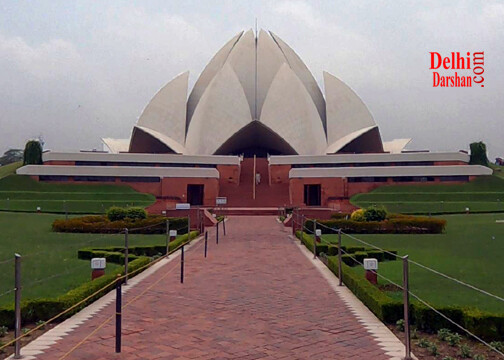Amidst the bustling city of Delhi, a magnificent architectural marvel awaits those seeking solace and spiritual rejuvenation. The Lotus Temple, an awe-inspiring structure, rises like a pristine lotus flower from the lush green surroundings, welcoming visitors from all walks of life. Embodying the essence of unity, peace, and oneness, this iconic temple stands as a symbol of India’s rich cultural diversity and religious harmony. Kindly WhatsApp us, for Delhi Darshan Agra bus, car, cab tour hire rental from Lotus Temple will provide you with city sightseeing.
An Oasis of Peace
The Lotus Temple is open to people of all religions and beliefs, offering a sanctuary for meditation, prayer, and quiet reflection. It adheres to the principles of the Bahá’í Faith, emphasizing the unity of all religions and the essential harmony between science and spirituality.
In the serene environs of the central prayer hall, visitors can experience a profound sense of tranquility and inner peace. The absence of religious symbols or rituals accentuates the universality of the temple’s message: that all humankind is one and should strive for the betterment of the world.
A Place for Spiritual Oneness
The unique structure of the Lotus Temple reflects the core teachings of the Bahá’í Faith, which advocate the essential oneness of all people and religions. The temple’s nine doors symbolize the inclusivity of the faith, inviting individuals from diverse backgrounds to seek spiritual solace and commune with the divine.
Throughout the year, the Lotus Temple hosts various devotional gatherings, readings, and musical performances that promote interfaith dialogue and unity. It has become a venue for fostering understanding and mutual respect among people of different faiths, encouraging a peaceful coexistence that transcends cultural and religious boundaries.
A Symbol of India’s Cultural Pluralism
The Lotus Temple stands as a testament to India’s cultural pluralism and its deep-rooted belief in religious tolerance. India, with its myriad religions and faiths, has long been a crucible of spiritual diversity and coexistence. The Lotus Temple exemplifies the nation’s commitment to cherishing and preserving this legacy of harmony and unity.
The temple’s location in Delhi, a city known for its rich historical tapestry and diverse population, further reinforces its significance as a symbol of India’s unity in diversity. It serves as a reminder that despite our varied beliefs and customs, we are all interconnected and bound by the common thread of humanity.
A Must-Visit Destination
For locals and tourists alike, the Lotus Temple is a must-visit destination that transcends mere sightseeing. It offers an opportunity to experience spirituality in a secular setting and bask in the tranquil aura of a sanctuary built on the foundations of love and harmony.
The Lotus Temple serves as a reminder that regardless of our religious affiliations or cultural backgrounds, we can find unity in embracing our shared humanity. It calls upon us to respect and honor the beliefs of others, fostering a world where understanding and acceptance reign supreme. Kindly WhatsApp us, for Delhi Darshan Agra bus, car, cab tour hire rental from Lotus Temple will provide you with city sightseeing.
History and Background:
The Lotus Temple was completed in 1986 and was designed by Iranian architect Fariborz Sahba. It belongs to the Bahá’í Faith, which emphasizes the unity of all religions and the oneness of humanity. The temple serves as a space for people of all faiths to come together, offering a place of worship and meditation.
Architectural Marvel:
The Lotus Temple’s design is a testament to human ingenuity and creativity. The structure resembles a blooming lotus flower, with twenty-seven pristine marble petals arranged in clusters of three, forming nine sides. The white marble exterior glistens in the sunlight, exuding a sense of purity and serenity. The temple’s construction involved the use of cutting-edge engineering techniques, combining modern technology with traditional craftsmanship.
Spiritual Significance:
The Lotus Temple is open to people of all religions, beliefs, and backgrounds. Its central prayer hall, devoid of any religious symbols, provides a tranquil atmosphere for individual prayer and meditation. Visitors are encouraged to connect with their inner selves, seek solace, and reflect upon their spiritual journey. The temple fosters a sense of unity among its visitors, promoting the belief that all religions lead to the same ultimate truth.
Environmental Stewardship:
Apart from its architectural brilliance, the Lotus Temple also showcases a deep commitment to environmental sustainability. The design incorporates energy-efficient features such as natural lighting, rainwater harvesting, and passive cooling systems. The temple’s lush green gardens and surrounding landscape create a serene oasis in the bustling city, promoting harmony between humanity and nature.
Global Recognition:
The Lotus Temple has garnered global acclaim and recognition for its architectural beauty and spiritual significance. It has attracted millions of visitors from all over the world, making it one of the most visited religious sites globally. In 2001, the temple received the prestigious GlobArt Academy Award for its architectural excellence, further cementing its position as a cultural and architectural marvel.
Conclusion:
The Lotus Temple stands as a testament to the power of unity, spirituality, and architectural brilliance. With its awe-inspiring design, welcoming atmosphere, and commitment to environmental sustainability, it continues to inspire and uplift individuals from diverse backgrounds. As a beacon of peace and harmony, the Lotus Temple serves as a constant reminder of the shared values that bind humanity together, transcending religious and cultural differences.
Visiting the Lotus Temple is an experience that leaves a lasting impression on the mind and soul, offering solace, reflection, and a renewed sense of connection. It embodies the notion that in a world filled with diversity, embracing unity and fostering understanding are the keys to a brighter and more harmonious future.
Lotus Temple is a Baha’i House of Worship that was completed in December 1986. Famous for its flower like shape, it has become a major attraction of Delhi. It is open to all, regardless of religion. Kindly reach Lotus Temple at its opening timings.
Lotus Temple Timings
| Day | Morning | Evening |
| Monday | 8am – 12pm | 2pm – 5pm |
| Tuesday | 8am – 12pm | 2pm – 5pm |
| Wednesday | 8am – 12pm | 2pm – 5pm |
| Thursday | 8am – 12pm | 2pm – 5pm |
| Friday | 8am – 12pm | 2pm – 5pm |
| Saturday | 8am – 12pm | 2pm – 5pm |
| Sunday | Closed | Closed |
Earlier Lotus Temple used to be closed on Monday, but now it is closed on Sunday. You must read our article “is it safe to travel to New Delhi” and “is Delhi Closed on Monday“.
Tourist Attractions Nearby:
- Delhi Eye
- Jahaz Mahal
- Qutub Minar
- Kalkaji Mandir
- Nandanvan Park
- Yogmaya Mandir
- Tughlaqabad Fort
- Akshardham Temple
- Okhla Bird Sanctuary
- Jain Mandir Dadabari
- Garden of Five Senses
- Jamali Kamali Mosque
- Nehru Place Computer Market
- Doctor Zakir Hussain Museum
- Gurudwara Baba Banda Singh Bahadur
Important Information:
- “Delhi Full Day Tour Packages“
- “Best Time to Visit Delhi“
- “Places to Visit in Delhi“
- “Delhi Agra Bus Tour“
- “Delhi Bus Tour“
- “Agra Darshan“
Other Options:
You may opt for Delhi VIP Tours or Delhi Darshan Cab Booking as well. Kindly WhatsApp us, for Delhi Darshan Agra bus, car, cab tour hire rental from Lotus Temple will provide you with city sightseeing.
The above-mentioned information may change from time to time. If you find any change in details, then kindly contribute with the latest information. Delhi Darshan has created this page for general information. So, that visitors to the city can get maximum output from their trip.
This post was last modified on 20 July, 2023 4:41 pm

